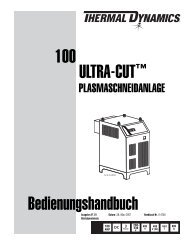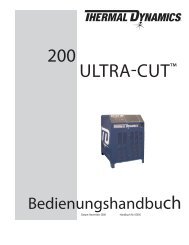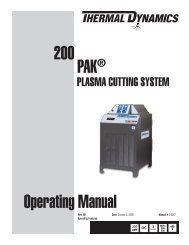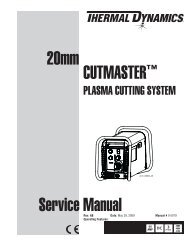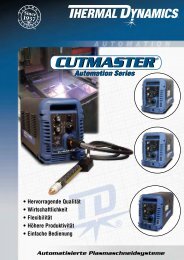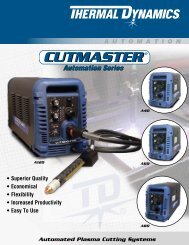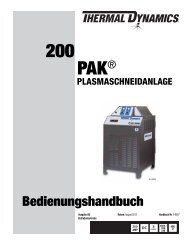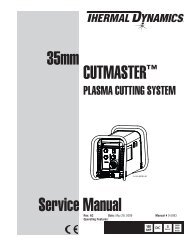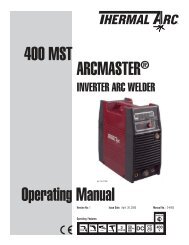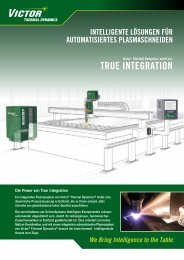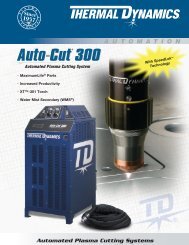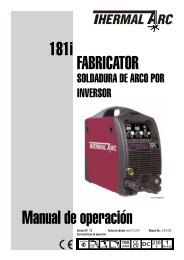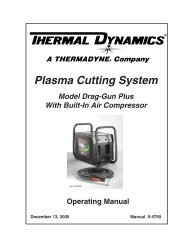211i Operating Manual FabricatOr® - Victor Technologies - Europe
211i Operating Manual FabricatOr® - Victor Technologies - Europe
211i Operating Manual FabricatOr® - Victor Technologies - Europe
You also want an ePaper? Increase the reach of your titles
YUMPU automatically turns print PDFs into web optimized ePapers that Google loves.
SAFETY INSTRUCTIONS FABRICATOR <strong>211i</strong><br />
NOTE<br />
1.02 Principal Safety Standards<br />
Considerations About Welding And The<br />
Effects of Low Frequency Electric and<br />
Magnetic Fields<br />
The following is a quotation from the General Conclusions<br />
Section of the U.S. Congress, Office of<br />
Technology Assessment, Biological Effects of Power<br />
Frequency Electric & Magnetic Fields - Background<br />
Paper, OTA-BP-E-63 (Washington, DC: U.S. Government<br />
Printing Office, May 1989): “...there is now<br />
a very large volume of scientific findings based on<br />
experiments at the cellular level and from studies with<br />
animals and people which clearly establish that low<br />
frequency magnetic fields interact with, and produce<br />
changes in, biological systems. While most of this<br />
work is of very high quality, the results are complex.<br />
Current scientific understanding does not yet allow us<br />
to interpret the evidence in a single coherent framework.<br />
Even more frustrating, it does not yet allow<br />
us to draw definite conclusions about questions of<br />
possible risk or to offer clear science-based advice<br />
on strategies to minimize or avoid potential risks.”<br />
To reduce magnetic fields in the workplace, use the<br />
following procedures.<br />
1. Keep cables close together by twisting or<br />
taping them.<br />
2. Arrange cables to one side and away from the<br />
operator.<br />
3. Do not coil or drape cable around the body.<br />
4. Keep welding Power Source and cables as far<br />
away from body as practical.<br />
ABOUT PACEMAKERS:<br />
The above procedures are among<br />
those also normally recommended for<br />
pacemaker wearers. Consult your doctor<br />
for complete information.<br />
Safety in Welding and Cutting, ANSI Standard Z49.1,<br />
from American Welding Society, 550 N.W. LeJeune<br />
Rd., Miami, FL 33126.<br />
Safety and Health Standards, OSHA 29 CFR 1910,<br />
from Superintendent of Documents, U.S. Government<br />
Printing Office, Washington, D.C. 20402.<br />
Recommended Safe Practices for the Preparation for<br />
Welding and Cutting of Containers That Have Held<br />
Hazardous Substances, American Welding Society<br />
Standard AWS F4.1, from American Welding Society,<br />
550 N.W. LeJeune Rd., Miami, FL 33126.<br />
National Electrical Code, NFPA Standard 70, from<br />
National Fire Protection Association, Batterymarch<br />
Park, Quincy, MA 02269.<br />
Safe Handling of Compressed Gases in Cylinders, CGA<br />
Pamphlet P-1, from Compressed Gas Association,<br />
1235 Jefferson Davis Highway, Suite 501, Arlington,<br />
VA 22202.<br />
Code for Safety in Welding and Cutting, CSA Standard<br />
W117.2, from Canadian Standards Association,<br />
Standards Sales, 178 Rexdale Boulevard, Rexdale,<br />
Ontario, Canada M9W 1R3.<br />
Safe Practices for Occupation and Educational Eye and<br />
Face Protection, ANSI Standard Z87.1, from American<br />
National Standards Institute, 1430 Broadway, New<br />
York, NY 10018.<br />
Cutting and Welding Processes, NFPA Standard<br />
51B, from National Fire Protection Association,<br />
Batterymarch Park, Quincy, MA 02269.<br />
<strong>Manual</strong> 0-5225 1-5 SAFETY INSTRUCTIONS AND WARNINGS



